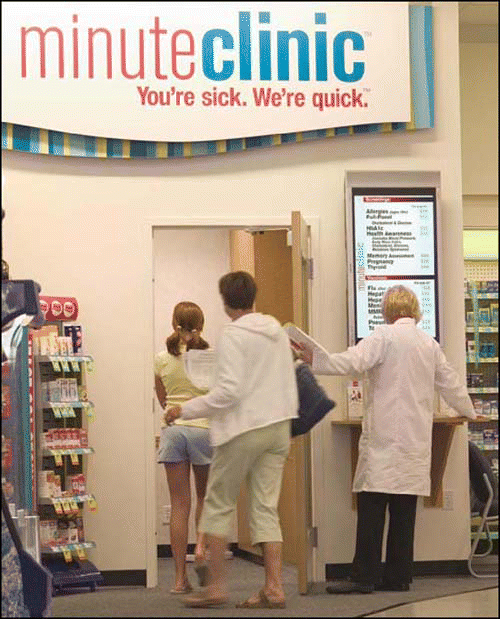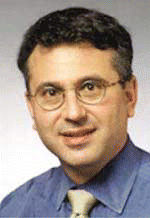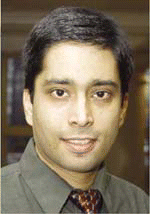Drop-in retail clinics staffed by nurse practitioners or physician’s assistants may represent a fundamental and permanent change in how patients receive minor primary care in this country, providing affordable care and convenience-but do they serve the long-term health interests of otolaryngology patients and the doctors who treat them?
Explore This Issue
September 2006The answer appears to be yes at this point in time, indicated Jack B. Anon, MD, Clinical Professor at the University of Pittsburgh School of Medicine (Pa.). Most ENT doctors don’t have the setup to see minor ear, nose, and throat emergencies on a routine basis, said Dr. Anon, who also has a private otolaryngology practice in Erie, Pa.
Because otolaryngologists-head and neck surgeons are specialists, continued Dr. Anon, they are going to be booked up well in advance with referrals from primary care physicians, so patients who have acute problems are usually going to end up in the family doctor’s office, and many of them will be seen by nurse practitioners or physician’s assistants.
So from our point of view as ENT doctors, a medical walk-in clinic is not going to have an impact on the economics of ENT; and as a matter of fact, if you talk to patients, very often now in our community especially, we find that if someone has an ear infection and they went to a family doctor, usually they were seen by a nurse practitioner or a physician’s assistant anyway.
Clinics May Offer Collaboration, not Competition
So is there a difference between a nurse practitioner or physician’s assistant in a doctor’s office and those in a CVS or Wal-Mart pharmacy? I think the answer is probably no, there is not a whole lot of difference, Dr. Anon said, and these walk-in clinics can serve the same purpose, if done properly.
Assuming that walk-in clinics are going to have a high quality of care and that there will be physicians available to answer questions and deal with complex problems, the clinics are actually a very reasonable medical option in today’s day and age, Dr. Anon said.
I think there are going to be some physicians who see these clinics as competition, Dr. Anon said. However, I don’t think the ENT doctor is going to see this as competition. The otolaryngologists in the community can become involved with the clinics, just as they would with a referring primary-care physician-they can offer assistance if needed in the otolaryngology area, and even give presentations on the latest advances in otolaryngology, including situations when it is advisable to refer a patient to an otolaryngologist-head and neck surgeon.

The Clinics
These drop-in clinics, including Minneapolis-based MinuteClinic and Take Care Health Systems of Conshohocken, Pa., are generally located in pharmacies, shopping malls, and retail stores.
Staffed by nurse practitioners and/or physician’s assistants, these clinics typically provide acute care services for minor problems for patients over 18 months of age.
The most common problems treated include pharyngitis, otitis media, conjunctivitis, bronchitis, sinusitis, and urinary tract infections, said Woody Woodburn, MD, Chief Medical Officer and Vice President of MinuteClinic.
MinuteClinic is the oldest retail health-care provider. We got started at the end of 1999, and we currently have 83 clinics in 10 states. By the end of the year we will have close to 250 clinics, Dr. Woodburn said.
MinuteClinic, which was acquired by CVS Corporation on July 12, 2006, includes locations in Atlanta, Baltimore, Charlotte, Columbus, Indianapolis, the Maryland Capital area, Minneapolis-St. Paul, Nashville, Orlando, Providence/Woonsocket, Raleigh/Durham, and Seattle.
Although acquired by CVS, Dr. Woodburn said MinuteClinics will not be exclusive to CVS.
Staffing and Guidelines
MinuteClinics are organized around small examination rooms in retail locations, Dr. Woodburn said. A nurse practitioner or a physician’s assistant staffs the clinic and provides diagnoses, treatment recommendations, and prescriptions for people with common family illnesses.
If you talk to patients, very often now in our community especially, we find that if someone has an ear infection and they went to a family doctor, usually they were seen by a nurse practitioner or a physician’s assistant anyway. – -Jack B. Anon, MD
We hire experienced family practice providers; we have people who are highly qualified and experienced in family medicine who are able to handle pediatric and adult issues, Dr. Woodburn said. Since these practitioners come to MinuteClinics with experience, training, credentials, and licensure, we then can, with about two weeks of education, get them up to speed on our operational systems.
MinuteClinics uses national clinical practice guidelines that have been developed by expert groups such as the American Academy of Family Practice and a regional group that is becoming national, called the Institute for Clinical Systems Improvement, Dr. Woodburn said. There are also AMA guidelines for walk-in clinics. A critical part of our foundation is national clinical practice guidelines.
A proprietary electronic medial record system that incorporates national clinical guidelines is in use at MinuteClinics. Also, an electronic chart review system allows overseeing physicians to do random samples every week or every month, assuring that the clinics provide high-quality and consistent care day in and day out, reported Dr. Woodburn.
Physician Participation
Physician oversight is a large component of the MinuteClinic program, Dr. Woodburn said. In every city where we have clinics, we have local physicians who are board certified, actively practicing primary care or family physicians, or emergency physicians who provide medical directorship activities. These are very high-quality, actively working physicians who are well known in the community, he added.
An attempt is made to refer patients to primary-care physicians, Dr. Woodburn said. We have strong referral relationships and know who the good ENT docs are in the communality. In addition, MinuteClinics has an electronic database that provides information from physicians who are accepting new patients. If a patient does not have a primary care physician, then we can provide a list of doctors in their neighborhood-and that is a value to the physician and certainly a value to our patients.
MinuteClinics also sends medical records to primary-care physicians if the patient already is being seen, letting them know what we did, what we saw, what the treatment plan was, because we believe that is critical-we share information with doctors that patient goes to see, added Dr. Woodburn.
Out of thousands of surveys, patients rate the care given as excellent, Dr. Woodburn reported, with an average of 93% satisfaction. He credits this high percentage of satisfaction to two main factors. First, nurse practitioners love to teach and they love to interact with people, and there is a very warm and immediate kind of relationship that develops.
The second factor is that because of the way the clinics are set up, the practitioner can spend more time with patients than the average busy physician. We have at least 15 minutes-and that gives time enough to educate and to talk, Dr. Woodburn said.
My suggestion, especially in the pilot phase, is that there should be some significant physician supervision when these clinics get rolled out. – -Neil Bhattacharyya, MD
The typical cost for a visit is about $49 to $59, which varies from state to state. Laboratory tests are extra and insurance covers much of the care, added Dr. Woodburn. We have strong national contracts with Cigna, Aetna, United Health Groups, and some Blue Cross and Blue Shield plans.
Clinics Need Continued Oversight
Although most reports on drop-in clinics are positive, since both the concept and practice are new, continuing oversight is necessary to assure that patients’ needs are met.
For many ENT-related disorders, there is going to be some value in terms of screening for hearing loss and other chronic conditions of the head and neck, said Neil Bhattacharyya, MD, Associate Professor of Otology and Laryngology at Brigham and Women’s Hospital of Harvard Medical School in Boston, Mass.
Staffed by nurse practitioners and/or physician’s assistants, walk-in clinics typically provide acute care services for minor problems for patients over 18 months of age.
In terms of treating acute problems, I think these clinics should be looked at very carefully on a continuing basis to determine accuracy of diagnoses and treatment outcomes relative to seeing an otolaryngologist. Oversight is also very important, he added.
Although nurse practitioners and physician’s assistants are experienced in many problems seen in a family practice setting, few of them have specific training in otolaryngology disorders. The problem is that, depending on the experience of the nurse or the nurse practitioner with ENT disorders, it can potentially lead to misdiagnoses and further problems down the line, said Dr. Bhattacharyya.
It would be helpful if the drop-in clinic practitioners have some supervised otolaryngology experience, added Dr. Bhattacharyya. We have seen people who have had sudden hearing loss who were seen in a clinic and were told it was fluid in the middle ear, but ended up having an inner ear hearing loss which probably should have been treated more urgently. In cases like this, seeing an otolaryngologist who would have typically prescribed steroids may have been better for the patient, he added. The problem is that these somewhat acute, but potentially threatening diagnoses are small, they are a needle in a haystack, but if [the drop-in clinic practitioners] have no experience with that diagnosis, it’s going to be hard for them to make it.
Hands-On Experience and Physician Supervision Recommended
Dr. Bhattacharyya said that if the clinics are going to be handling otolaryngology problems, especially if it’s on an acute basis, I would really think they need to be rotating with an otolaryngologist to perhaps get some hands-on experience; I think that would be a good addition to their training before they start manning one of these clinics.
Another issue, said Dr. Bhattacharyya, is that otolaryngology overlaps with many other medical disciplines, so sometimes even for a seasoned otolaryngologist, there is a problem distinguishing between overlapping conditions, and again if there is a limited experience, there could be a number of misdiagnoses.
A complete head and neck exam is necessary for most of these patients who come in with otolaryngology problems, said Dr. Bhattacharyya, and many nurse practitioners do not have that training.
My suggestion, especially in the pilot phase, is that there should be some significant physician supervision when these clinics get rolled out, then I think they need to do a good follow-up on their treatments and diagnoses, to make sure there is good accuracy, he added.
©2006 The Triological Society


Leave a Reply